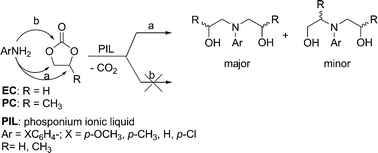The reaction of primary aromatic amines with alkylene carbonates for the selective synthesis of bis-N-(2-hydroxy)alkylanilines: the catalytic effect of phosphonium-based ionic liquids†
Abstract
At T ≥ 140 °C, different primary

* Corresponding authors
a
Dipartimento di Scienze Ambientali dell'Università Ca' Foscari Calle Larga, S. Marta 2137 – 30123, Venezia, Italy
E-mail:
selva@unive.it
At T ≥ 140 °C, different primary

 Please wait while we load your content...
Something went wrong. Try again?
Please wait while we load your content...
Something went wrong. Try again?
M. Selva, M. Fabris, V. Lucchini, A. Perosa and M. Noè, Org. Biomol. Chem., 2010, 8, 5187 DOI: 10.1039/C0OB00105H
To request permission to reproduce material from this article, please go to the Copyright Clearance Center request page.
If you are an author contributing to an RSC publication, you do not need to request permission provided correct acknowledgement is given.
If you are the author of this article, you do not need to request permission to reproduce figures and diagrams provided correct acknowledgement is given. If you want to reproduce the whole article in a third-party publication (excluding your thesis/dissertation for which permission is not required) please go to the Copyright Clearance Center request page.
Read more about how to correctly acknowledge RSC content.
 Fetching data from CrossRef.
Fetching data from CrossRef.
This may take some time to load.
Loading related content
